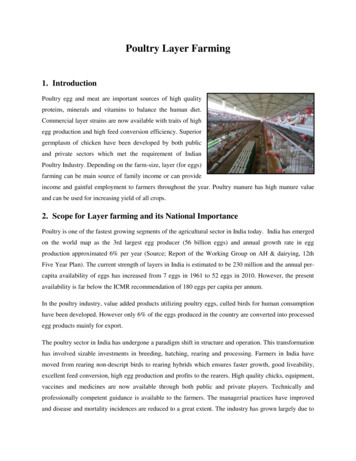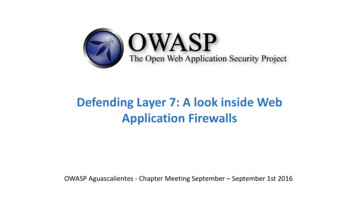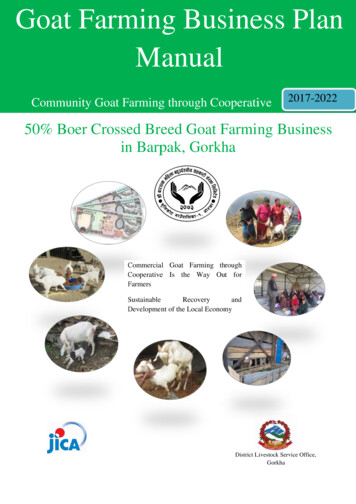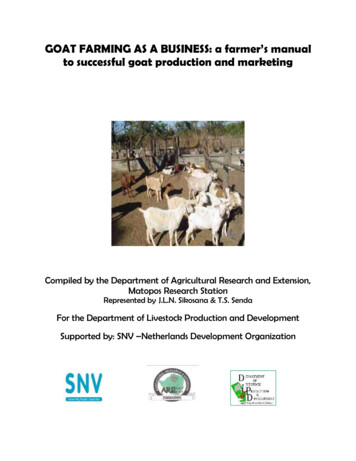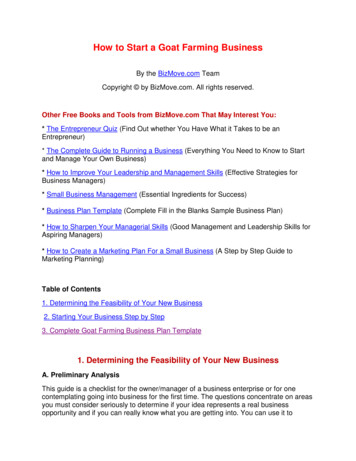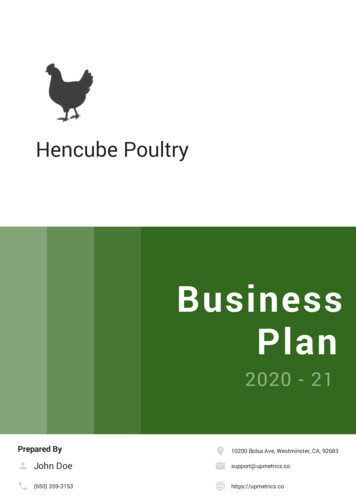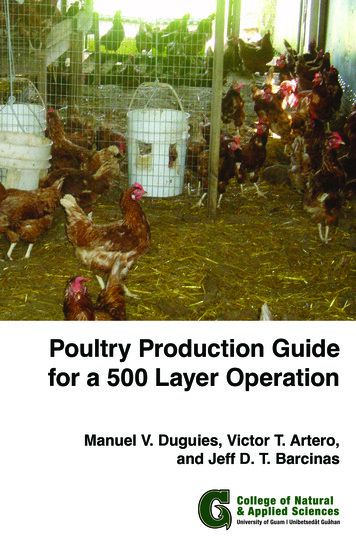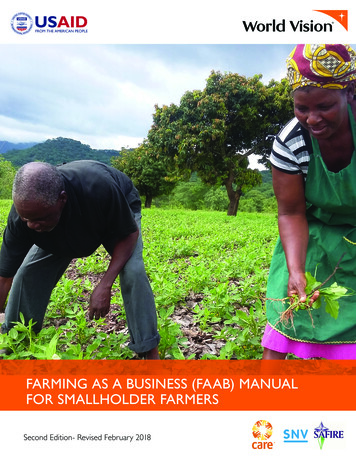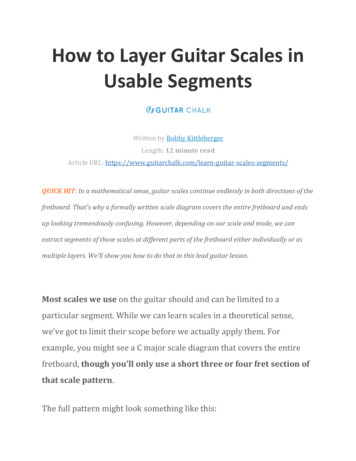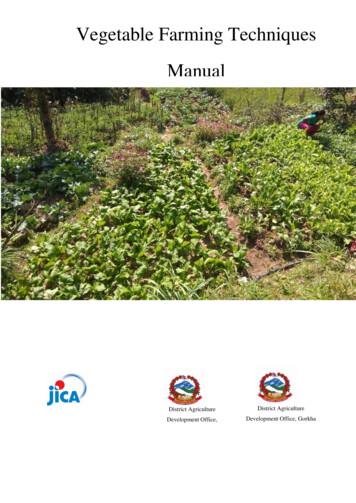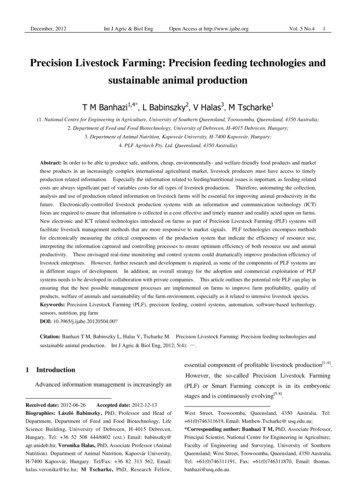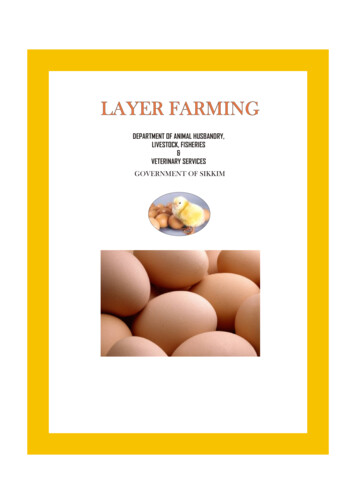
Transcription
LAYER FARMINGDEPARTMENT OF ANIMAL HUSBANDRY,LIVESTOCK, FISHERIES&VETERINARY SERVICESGOVERNMENT OF SIKKIM
CONTENTSSl. .20.TOPICIntroductionCommercial layer breedsDual Purpose breedHousing and Management of commerciallayersSystems of housingManagementBrooding in deep litter systemManagement of chicks in brooderManagement of growersManagement of layersFloor space requirementLitter managementPoultry feedFeeding scheduleEffective micro-organism liquid (E.M.)Application in broiler productionSome of common diseases affecting layersVaccination schedule in layersBio-security measures in a broiler farmScheme for establishment of 500 Nosof Kalinga Brown commercial layer farmScheme for establishment of 1,000 Nosof Kalinga Brown commercial layer farmComparative income statement between agovernment servant and a poultry farmerPage No.1111-2233445556677-991011-1213-1415
COMMERCIAL LAYER FARMINGA layer is a commercially viable egg producing bird.Egg is in great demand because of its nutritive value, easy and quickpreparation time and as co-ingredient in wide variety of preparation(house-hold and commercial).Hence layer farming has gained importance as the fastest growing industry inlivestock sector.BREED:1.Commercial Layer Breed:a. White Leghornb. Kalinga Brownc. Cari Goldd. Coloured Layer2.Dual Purpose breed: a. Kuroiler Dualb. RhodeIsland Redc. VanarajaHOUSING & MANAGEMENT OF LAYERSA comfortable, easy to clean and manage, providing sufficient area for thecomfort of the bird is essential requisite for getting optimum growth andproduction in layer farming.1
Location of Poultry House:1) Away from residential or crowded areas.2) Accessible to the market for eggs and availability of poultry feeds.3) Well connected with roads for transportation.4) Provision of electricity and clean water.Requirement of a good housing1)Well ventilated house.2)House built in east to west direction along the long axis of the house fornatural light and sun rays.3)Temperature 20o-25o C.4)Floor Concrete, rain proof, crack-free, rat-proof and easy to clean.5)Roof- should be moist proof, and common roofing materials may beasbestos, fibre sheet, thatch/chitra etc.6)Light- Daylight desirable.7)Sanitation Ease in cleaning and spraying disinfectants / sanitisers.8)Height of the house 3 mts from the foundation to the roof.Systems of HousingA. Intensive system (commercial)of housing includes:1) Cage system:2) Deep litter system: Covering of floor with litter materials like saw-dust,rice-husk, chopped wheat straw (Depending upon the availability).2
For building a Low cost housing system, locally available material likebamboo and mud (for walls) can be used .For layers, cages made out ofbamboo can be made to house the birdB. Back-YardMANAGEMENTBrooding: is the caring of the chicks from day old till 88 weeks of age. It isdone in order to prevent chick mortality and achieve maximum growth byproviding warmth to the chicks.Natural Brooding:Under normal condition, the mother hen provides the chicks with the warmthof the body and looks after the feeding too.Artificial Brooding:Under artificial brooding, a temperature controlled artificial brooder is used inplace of mother hen.Following points must be followed when brooding artificially:BROODING IN DEEP LITTER SYSTEMPreparation before the arrival of chicks: Sheds should be vacant for at least 3-4 weeks. Thoroughly wash and disinfect all the walls , ceilings, floors, crevicesand equipments. Clean all the water lines and channels. White wash the walls of the house.oo Set heating system 90 -95 F in floor brooding. Brooder should be provided in circular fashion. Provide clean litter material(2-4 inches deep) inside the brooder guard.3
MANAGEMENT OF CHICKS IN THE BROODER (0-8WKS) Provide 6 sq inches per chicks under the brooder.oo Brooding should be started at 95 F temperature and be reduced by 5 Foevery week until 70 F is attained. De-beaking may be done at 3rd week of age. Provide continuous light during brooding period. Provision of clean fresh water. Daily inspect the condition of birds for any abnormalities. Height of the feeder should be adjusted to the convenience of the chicks. Keep a standby in case of emergency electricity failure.Brooding Temperature:Patterns of chick distribution under electric brooder-Comfortable ZoneTemperature too highTemperature too lowManagement of Growers (9-20 weeks) Birds should be transferred to grower house at 9 weeks of age. Waterer and feeders should be adjusted as per the need of the birds. Grower mash should be fed to the birds. Keep provision for cross ventilation. De-beaking may be done if necessary. Vaccinate birds as per schedule. Check feed intake and body weight at regular interval. Provide light 12 hrs a day. Culling of underdeveloped, diseased type of undesirable pullets as earlyas possible.4
Management of Layers (21-72 weeks) Ventilation in the layer house should be adequate without drafts. Feed layer mash to the birds. Provide laying nest/box to the birds, use clean bedding material in thelaying nest. Replace nesting material at regular intervals. Eggs should be collected 3-4 times a day in deep litter system ofhousing. Treatment may be made against external parasites like ticks, mites andlice periodically. Remove dead birds promptly and dispose them properly. Light should start from 12 hrs a day & increased by 15-30 minutesevery week until 16 hrs of light is reached.FLOOR SPACE REQUIREMENTDeep Litter SystemCage SystemBROODER HOUSE0.7 sq ft/bird0.5 sq ft/birdGROWER HOUSE1 sq ft/bird0.6 sq ft/birdLAYER HOUSE2 sq ft/bird0.7 sq ft/birdLitter Management:Total height of the litter should be 5 cms, maintained dry, turned frequentlyand treated with hydrated lime.5
POULTRY FEEDAs feed is the major cost of poultry production and which significantlyaffects the production performance of the birds. So feed and feeding is themost important consideration for efficient poultry farming. Improper feedingnot only affects the production performance but also causes several deficiencydiseases.Also, the feed needs to have all the nutrients (carbohydrates, protein , fats,minerals & vitamins) in right proportion. In addition some additives tofacilitate digestion and growth is often added in reputed commercial feed.Estimated Feed consumption of Layers:FEEDING SCHEDULE OF LAYER BIRDSAT CHUJACHEN LIVESTOCK FARMAge in weeks1st week2nd week3rd week4th week5th week6th week7th week8th week9th week10th week11th week12th week13th week14th week15th week16th week17th week18th week19th week20th week21st week22nd week23rd weekWeight in gramsFull feed (Adlibitum)Full feed /bird/day116gm/bird/day125gm/bird/day6
EFFECTIVE MICRO-ORGANISM LIQUID (E.M.)APPLICATION IN LAYER PRODUCTIONE.M. Is a brown concentrated liquid produced from thecultivation of 80 strains of beneficial micro-organisms collectedfrom natural environment of India.Advantages of E.M. Technology in Livestock Production:Reduces cost inputs more efficiently.Improves egg production.Clean shed, less flies, ticks and less disease incidence.Maintains better health condition of birds.E.M. solution as additive in drinking water on daily basis :E.M. SolutionAge of bird(day)01- 14 days1 ml / litre of water15 onwards0.5 ml / litre of waterCaution:E.M. Solution should not be mixed with anti-biotic, chlorinated water /any disinfectants.Diseases-Layers are affected by different diseases which may be caused byvirus, bacteria ,fungi etc.Some of the common diseases affecting layers are as followsA)Viral1)Ranikhet / New Castle DiseaseSymptoms:i. Affects all the birds of the farm.ii. Difficulty in breathing.iii.Nasal discharge.iv. Anorexia.v. Greenish diarrhoea.vi. 90-100% mortality.Prevention: early vaccination with F1 followed by R2B vaccines.7
2)Marek's DiseaseSymptoms:i. Affects all the birds.ii. Droopy wings, lameness, paralysis.iii. 60- 70% mortality.Treatment : No treatment, only early vaccination.B)Bacterial Diseases1) SalmonellisisSymptoms:i.Chalky white diarrhoea.ii.Pasted vent.iii.Depression and loss of weight.iv.Sudden death.v.Affects all age groups.Treatment:i.Use effective antibiotic (contact nearest veterinary centre).ii.Recovered birds act as a source of disease and thus better to cull.2) ColybacillosisSymptoms:a) Affects all age groups.b) Diarrhoea.c) Dizziness.d) Swelling of joints.e) Oedematous comb and wattle.f) Mortality rate - 90%.Treatment:Antimicrobials (contact nearest veterinary centre).C)Fungal Diseases1) Brooder pneumonia / aspergillosisSymptoms:a) Affects chicks.b) High mortality.c) Respiratory problem.d) Swollen eye and head.Treatment:Use antifungal (contact nearest veterinary centre).8
D) Helminthic DiseasesSymptoms:a) Affects mostly layer birds.b) In appetence.c) Poor body growth.d) Ruffled feather.e) Diarrhoea.Treatment:Use anthelmintic every two months (contact nearest veterinary centre).E) Protozoan Diseases1) CoccidiosisSymptoms:a) Decrease in egg production.b) Bloody diarrhoea.c) High mortality rate.Treatment:1) Proper management.2) Use anti-coccidiosis (contact nearest veterinary centre).VACCINATION SCHEDULEDiseaseMarek's 1st dayRanikhetRanikhetRanikhetFowl PoxFowl PoxGumboro / IBDAge(generally given inhatchery) 0.2ml s/c3-4th day (f-strain)5-6th wk (f-strain)10-12th wk (R2B)3rd wk P.P.V.L.8th wk (P.P.C.E.D.L.)15th -18th day (on advice by vet)9
BIO-SECURITY MEASURES IN A LAYER FARMBio-security is a practice designed to prevent the spread of disease onto yourfarm.Bio-security has three major components:1. Isolation.2. Traffic Control.3. Sanitation.Bio-security MeasuresFencing.Keep visitors to a minimum.Limit visits to other poultry farms.Keep all animals and wild birds out of poultry houses.Practice sound rodent and pest control program.Inspect flocks daily and recognize disease symptoms.Good ventilation and relatively dry litter.Keep areas around houses and feed bins clean.No exchange of feed and equipments.Disinfection and sanitization of poultry house & equipments.10
SCHEME FOR ESTABLISHMENT OF 500 NOS .OF KALINGA BROWNCOMMERCIAL LAYER FARM.Sl.NoParticularA.ICapital ExpenditureCost of construction one no. of brooder cum rearingshed space size 1’6” per bird a low cost poultry shedwith cemented floor size 800 sqft 26’6”x 30’ 798sqftCost of Poultry equipment such as Feeder, waterer,brooder& misc. itemsCost of othe expenditure on power, adm.and otherunforeseen expenditureCost of electrification 4 % of civil work of poultryshedII.III.IV.Rate EstimatedCost (in 250.002,872.80TOTALB.Recurring ExpenditureCost of Day old Kalinga Brown Parent Line Chicks 500Expenditure on purchase of Feed per CycleCost of Chick Mash requirement (0-8week ) 2 kg 1,000kgGrower mash ( 9-20 week) 5 kg 2500kgLayer mash ( 21-72 week) 40kg 20,000 kg23500kgCost of Poultry Medicines, Vaccines, Litter andinsurance coverageProject CostCapital Expenditure 88,442.80( ) Recurring Exp. 3,57,2504,45,692.80Term loan 75% 3,34,269.60Income Generated Mortality 6% 30 03,57,250.00
RETURNS:Sl.NoParticular1.Total no. of table eggs producedfrom 470 nos Layers @ 230 eggs/annumGood eggs collected 80% of totalproduction20% broken eggs collected 21,620out of which:70% Sold 15,13430% Discarded 6,486Average broken eggs/ day 21 nos.( 10 months)Sale of culled bird 470 nos. at theage of 72 week age, average weight2 kg 500 gm 1175kgGunny bag 335 nosPoultry manure from 470 birdsa.b.2.3.4.No. of eggs1,08,100Rate-86480 Rs.5/ each15134648643,2400Rs.2/ 004,122.805,48,200.00(-) Capital Expenditure A III &IV( Recurring Expenditure)GROSS PROFIT(Rs 5,48,200.00- Rs 3,57,250.00)Net ProfitLess Depreciation onPoultry Shed10 % 7182.00Poultry equipment 15% 1875.00Net Profit/ bird 057.001,81,893.20Production Cost of an eggCalculation TableTotal feed consumed during LayingPeriod x cost of feed other inputi.e 25% of feed costTotal no. of egg produced/ Annum,Production cost of an egg23,500kg x Rs.14.50 Rs 3,40,750.00 Rs 85,187.50 Rs 4,25,937.5 1,08,100 Nos Rs.3.94/eggOr Rs 1.06/egg profit if sold@Rs.5/each12
SCHEME FOR ESTABLISHMENT OF 1000 NOS .OF KALINGA BROWNCOMMERCIAL LAYER FARM.Sl.NoParticularA.ICapital ExpenditureCost of construction one no. of brooder cumrearing shed space size 1’6” per bird a low costpoultry shed with cemented floor size 800 sqft33’3”x30 99,989 sqftCost of Poultry equipment such as Feeder,waterer, brooder& misc. itemsCost of othe expenditure on power, adm.and otherunforeseen expenditureCost of electrification 4 % of civil work of poultryshedII.III.IV.B.Rate EstimatedCost (in Rs)Recurring ExpenditureCost of Day old Kalinga Brown Parent LineChicks -1000Expenditure on purchase of Feed per CycleCost of Chick Mash requirement (0-8week ) 2 kg/chick 2,000kgGrower mash ( 9-20 week) 5 kg 5,000kgLayer mash ( 21-72 week) 40kg 40,000 kg47,000kgCost of Poultry Medicines, Vaccines, Litter andinsurance coverageProject CostCapital Expenditure 1,21,006.40( ) Recurring Exp. 7,55,000.008,76,000.00Term loan 75% 6,57,004.50Income Generated Mortality 6% 60 5147,500.005,60,000.004.50/bird4,500.007,55,000.00
RETURNS:Sl.No1.a.b.2.3.4.ParticularTotal no. of table eggs produced940 nos Layers @ 230 eggs/ annumGood eggs collected 80% of totalproductionBroken eggs collected 43,240 nosout of which:70% Sold 30,268 nos30% Discarded 6,486Average broken eggs/ day 21 nos.( 10 months)Sale
BIO-SECURITY MEASURES IN A LAYER FARM Bio-security is a practice designed to prevent the spread of disease onto your farm. Bio-security has three major components: File Size: 1MBPage Count: 18
